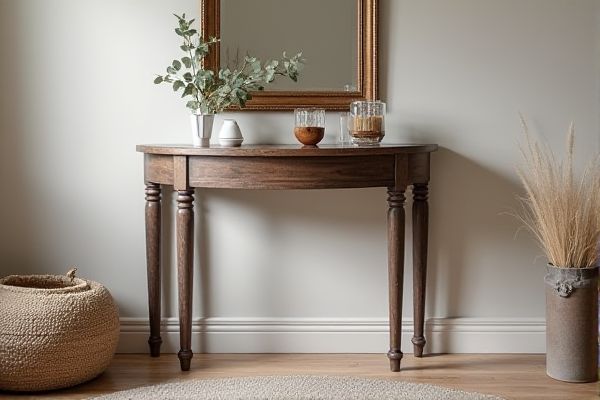
Demilune tables feature a distinctive half-moon shape, designed to fit snugly against a wall and provide elegant accent surfaces, while console tables typically have a rectangular form offering versatility for entryways or living rooms with added storage or display space. Discover which style best suits your home's aesthetic and functional needs by reading the rest of this article.
Table of Comparison
| Feature | Demilune Table | Console Table |
|---|---|---|
| Shape | Semi-circular (half-moon) | Rectangular or narrow |
| Primary Use | Entryway, hallway, accent piece | Entryway, hallway, display surface |
| Placement | Flush against wall | Flush against wall or open spaces |
| Storage | Limited, often shelf or drawer | Varies: shelves, drawers, or none |
| Design Style | Traditional, Classic | Modern to traditional |
| Footprint | Compact, space-saving | Variable, generally longer |
| Common Materials | Wood, metal | Wood, metal, glass |
Introduction to Demilune and Console Tables
Demilune tables feature a distinctive half-moon shape designed to fit snugly against walls, making them ideal for hallways or entryways. Console tables typically have a rectangular design with slim profiles, often placed behind sofas or along walls to display decor or hold essentials. Your choice between these tables depends on available space and aesthetic preferences, balancing form and function.
Defining Features of Demilune Tables
Demilune tables feature a distinctive half-moon shape with a flat back, allowing them to fit flush against walls and save space in entryways or narrow hallways. Their curved front and slender legs create an elegant, decorative look that contrasts with the straight lines and rectangular shape of console tables. You can use demilune tables to add a touch of classic sophistication while maintaining functionality in compact areas.
Key Characteristics of Console Tables
Console tables typically feature a narrow, rectangular design ideal for hallways or entryways, offering functional surface space without occupying much room. They often include one or more drawers for storage and are designed to be placed against a wall, enhancing decor while holding keys, lamps, or decorative items. Unlike demilune tables, which have a distinctive half-moon shape, console tables emphasize straight lines and versatility in placement and use.
Design Differences: Shape and Size
Demilune tables are characterized by their half-moon shape and typically smaller size, designed to fit snugly against a wall or in entryways, providing a subtle decorative surface. Console tables are usually rectangular and longer, offering more surface area suitable for hallways or behind sofas. Your choice depends on available space and the desired visual impact, with demilune tables enhancing compact areas and console tables serving as prominent storage or display pieces.
Functional Uses in Home Decor
Demilune tables provide compact, elegantly curved surfaces ideal for entryways or narrow halls, perfect for displaying decorative items without consuming excessive space. Console tables, larger and often rectangular, serve multifunctional roles in living rooms or dining areas, accommodating lamps, storage, and serving stations. Your choice depends on spatial needs and desired functionality, balancing visual appeal with practical use in home decor.
Placement Options: Entryways, Hallways, and More
Demilune tables, with their half-moon shape, fit snugly against walls, making them ideal for narrow entryways and hallways where space is limited. Console tables, often rectangular and slim, offer versatile placement options in entryways, behind sofas, or along longer walls, providing ample surface area for decor and storage. Both table types enhance small spaces while maintaining functionality and style.
Style Variations and Materials
Demilune tables feature a distinctive half-moon shape and often showcase traditional styles with curved legs, carved details, and materials such as wood, marble, or glass, emphasizing elegance in entryways or hallways. Console tables, which come in various shapes like rectangular or narrow designs, offer a broader range of styles from modern minimalist metal and glass to rustic wooden finishes, making them versatile for different interior aesthetics. Both tables utilize diverse materials like solid wood, metal, and stone, but console tables typically present more contemporary and multifunctional design options compared to the classic, ornamental appeal of demilune tables.
Storage Solutions: Drawers and Shelving
Demilune tables typically offer a single drawer or an open shelf, providing minimal but elegant storage ideal for small items or decorative pieces. Console tables often feature multiple drawers and lower shelving, maximizing storage capacity for organizing essentials like keys, mail, or books in entryways or living spaces. Choosing between the two depends on your need for versatile storage solutions versus a sleek, space-saving design.
Choosing the Right Table for Your Space
Demilune tables, featuring a half-moon shape, are ideal for narrow entryways or hallways where space efficiency and decorative appeal are priorities. Console tables, typically rectangular and slim, offer versatile surface area for displaying art or holding essentials in living rooms and behind sofas. Selecting between the two depends on your spatial constraints, stylistic preferences, and functional needs to maximize room flow and aesthetic harmony.
Summary: Demilune Table vs Console Table
Demilune tables feature a distinctive half-moon shape ideal for narrow spaces and elegant accent placement in entryways or hallways. Console tables are typically rectangular, designed to provide functional surface area against walls for decorative items, storage, or workspace solutions in living rooms or foyers. Both styles enhance interior design by combining aesthetic appeal with practical use, but their shape and placement versatility differentiate them significantly.
 homyna.com
homyna.com